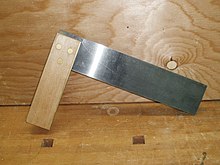Angle (tool)
An angle or angle measure is a form gauge that consists of two legs arranged at right angles . The angle is used in wood , stone and metal processing as well as in the building trade .
Designs
Depending on the area of application, there are differently constructed angles:
- The flat angle is made of flat steel .
- With the stop bracket , one of the two legs is designed as a stop with which it can be placed on straight edges. Stop angles used in woodworking are made of wood, often in combination with brass-coated edges, while the second leg is made of steel. The stop bracket used in metalworking usually consists entirely of tool steel .
- The hair angle is made of special steel for gauges with a defined measuring edge on both sides of the longer leg. The measuring edge is a cross-section such as cutting tapered ground , the short leg is ground flat. The measuring edge reveals slight deviations and unevenness in the backlight.
application
The angle has two main purposes: On the one hand, it is used to draw or draw lines at right angles to a reference edge or another line. On wood this is done with a pencil , on metal with a scriber . The material is shortened, drilled or processed in another way on the marked line. On the other hand, the angle is used to check the right-angled position of edges, surfaces or reference lines to each other (e.g. the center line of a row of holes) after machining.
The handling is different depending on the type of angle.
- With the simple angle, the inside of a leg is placed slightly downwards at the edge of the material.
- With the stop angle for woodworking, the thicker leg is placed on the edge of the material.
- With the stop bracket for metalworking, the stop is placed on the edge of the workpiece.
Examination of angles
Whether the angle actually provides an exact right angle is checked by "envelope": One leg of the angle (usually the shorter one) is placed on a straight edge, while a pencil line or a tear is drawn with the scriber on the longer leg. Then the angle is "turned over", i. H. the shorter leg of the bracket is placed on the other side. The pencil line or tear must run parallel to the longer leg if the angle is “right” or “right”.
In Germany, the DIN 875 standard specifies the most important design and measurement features and their testing. According to this standard, flat, stop and straight angles are divided into tolerance classes 00, 0, 1 and 2. The tolerance class is usually specified as the accuracy quality or degree of accuracy (abbreviated as GG 00, GG 0, GG 1 and GG 2). The steel angle is available in the tolerance classes according to DIN 875 or as a (non-certified) workshop angle, with 00 being the most precise tolerance. As a rule, the angles are sold with a corresponding test certificate.
For woodworking, the desired angular accuracy is usually somewhat lower than for metalworking. In Germany carpenter angles are not standardized, so checking the accuracy is up to each user.
Miter measure and octagon
The miter measure is a stop angle in which the legs form an angle of 45 °. It is used for marking and checking mitres . Some 90 ° angles can also be used as a gauge with a 45 ° short side of the stop leg. An octagon was called an angle whose legs formed an angle of 67.5 ° and which was used to prepare wooden parts for an octagon.
The angle as a symbol
The square has been one of the iconographic attributes of the Apostle Thomas , the patron saint of builders , since the end of the Middle Ages .
The most famous symbolic representation of the angle today can be found in the symbol of Freemasonry , which consists of the two tools angle and compass . The angle is interpreted in different ways, most often as a symbol of straightness and honesty. Previous symbolic representations of the angle include i.a. a. the throne of the Egyptian god Osiris , various allegorical representations of Geometria in the Middle Ages (as part of the Seven Liberal Arts ) and several times in the alchemical symbolism of the early modern period.
See also
- angle
- Related tools: goniometer , tear bar , sine ruler, and centering square
- Bevel
- Corner of hair
- Angle measure (heraldry)
Web links
Individual evidence
- ↑ a b Wolfgang Nutsch and others: expertise for carpenters. 12th edition. Verlag Europa-Lehrmittel, Wuppertal 1980, ISBN 3-8085-4011-7 , p. 231.
- ↑ cf. The angle - history, designs and use
- ↑ Wolfgang Nutsch and others: expertise for carpenters. 12th edition. Verlag Europa-Lehrmittel, Wuppertal 1980, ISBN 3-8085-4011-7 , p. 232.
- ^ Karl Karmarsch: Manual of mechanical technology. Volume 1, Helwing, Hannover 1857, p. 671.
- ↑ On the origin of the square measure and compass ( memento of the original from April 16, 2017 in the Internet Archive ) Info: The archive link was automatically inserted and not yet checked. Please check the original and archive link according to the instructions and then remove this notice.



